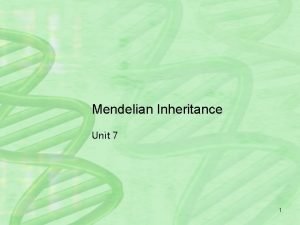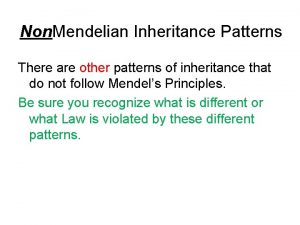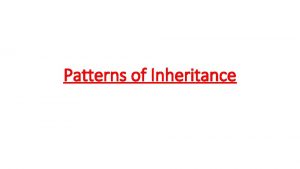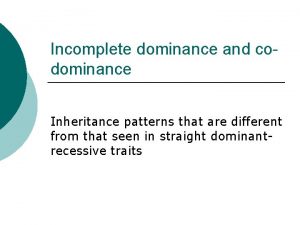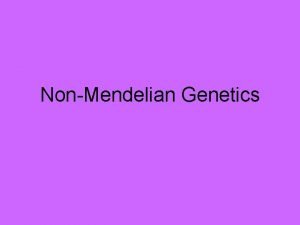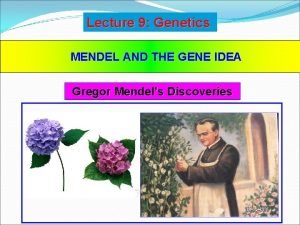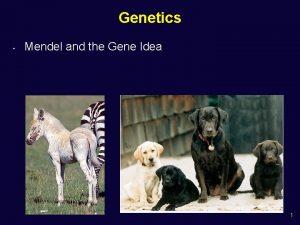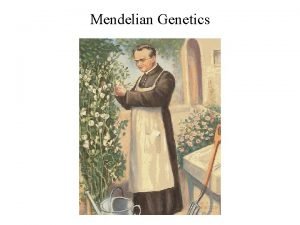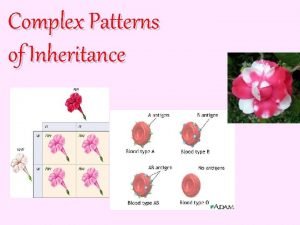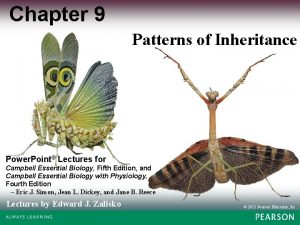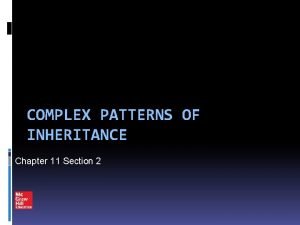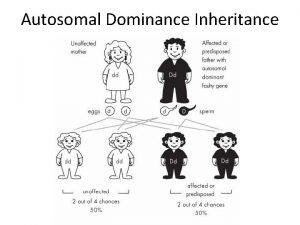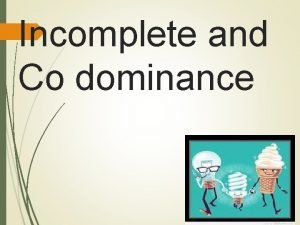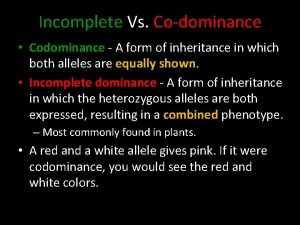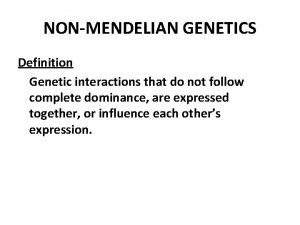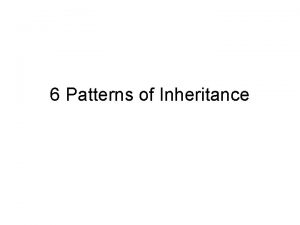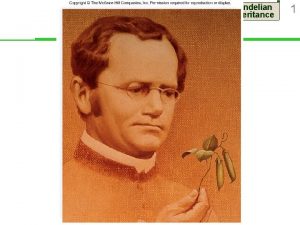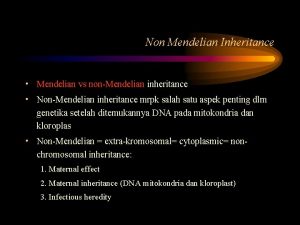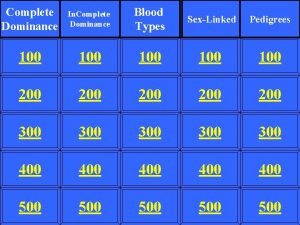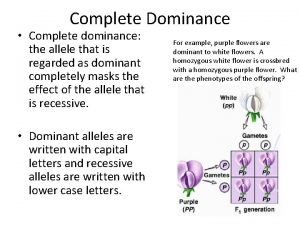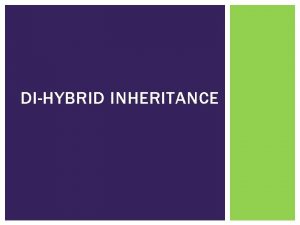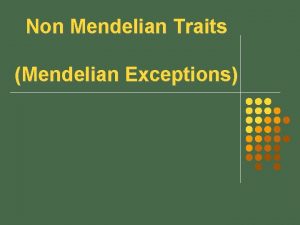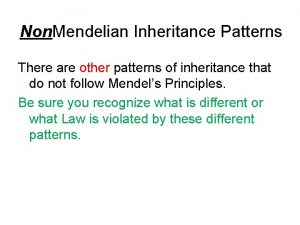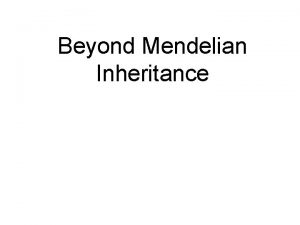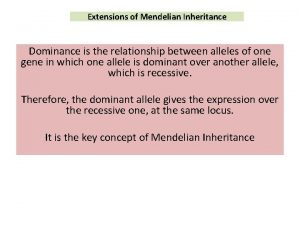Patterns of Inheritance 1 Complete Dominance Mendelian Dominance




















- Slides: 20

Patterns of Inheritance

1) Complete Dominance • (Mendelian Dominance) Homozygous dominant and heterozygous individual has same phenotype. • TT = tall ; Tt = tall • Results in only 2 variations


Other types of Inheritance • Some alleles are neither dominant nor recessive, and many traits are controlled by multiple alleles or multiple genes

Incomplete Dominance • When one allele is not completely dominant over the other. • Heterozygous phenotype is between the two homozygous phenotypes. FF FF’ F’F’


Incomplete Dominance • A cross between red (RR) and white (R’R’) four o’clock plants produces pink -colored flowers (RR’). F F F’ FF’ FF’

Codominance • Phenotypes of both homozygotes produced in heterozygote. • Neither allele is dominant over the other (both expressed). • Chickens have white feathers, black feathers, and black and white feathers • New allele format: BB = Black feathers (homo) WW = white feathers (homo) BW = Black & White feathers (hetero)


4) Sex Linked: • In humans, 46 total chromosomes w/ 23 pairs • 22 of those are homologous = autosomes • 1 pair are the sex chromosomes (different for males and females)


4) Sex Linked: • What are the chances of getting a boy to a girl? • Some traits besides just sex determination are found on the sex chromosomes. • Traits located on X chromosome • Boys need only 1 allele to express trait. • Colorblind

5) Polygenic Inheritance: • Several genes reflect multiple additive contributions to a phenotype. • These traits have a variety over a wide range. • Ex: Height, Weight, Skin Pigment • The greater the # of genes, the wider the range of variety.

5) Polygenic Inheritance: • Ex: 3 genes control the mass of bristle worms, and every dominant allele contributes 1 g. • How many alleles/gene? • How many alleles are there for mass in bristle worms? • Homozygous skinny = 2 g (genotype? ) • How much mass would the fattest bristle worm have? • The mass of most bristle worms would be?

5) Polygenic Inheritance:

6) Multiple Allele: • When genes can have more than 2 possible alleles for a characteristic in the population’s gene pool. • Any individual organism still inherits only two alleles (one from each parent)

• Different combinations of alleles result in the KEY colors shown here. C= full color; dominant to all other alleles cch = chinchilla; partial defect in pigmentation; dominant to ch and c alleles ch = Himalayan; color in certain parts of the body; dominant to c allele chch ch ch AIbino: Chinchilla: Himalayan: cc CC, ccchhcc, h. Cc , c or c, hhor cch c Full color: , Cc , or Cc c = albino; no color; recessive to all other alleles

6) Multiple Allele: • Ex: Many codominant alleles in human blood types. • The gene encodes an enzyme that adds sugar molecules to the plasma membrane of red blood cells. Act as recognizing markers for the antibodies for the immune system. • Gene is designated I and has 3 possible alleles. • IA, IB, and i • IA and IB are codominant. • Both I’s are completely dominant over i. Figure out how to get the A, B, AB, and O blood types


 Difference between mendelian and non mendelian inheritance
Difference between mendelian and non mendelian inheritance Mendelian inheritance patterns
Mendelian inheritance patterns Complete dominance pattern of inheritance
Complete dominance pattern of inheritance Codominant inheritance patterns
Codominant inheritance patterns Mendel's three laws
Mendel's three laws Non mendelian inheritance
Non mendelian inheritance Mendelian genetics
Mendelian genetics Cystic fibrosis mendelian inheritance
Cystic fibrosis mendelian inheritance Dominant or recessive
Dominant or recessive Probability laws govern mendelian inheritance
Probability laws govern mendelian inheritance Chapter 11 section 1 basic patterns of human inheritance
Chapter 11 section 1 basic patterns of human inheritance Complex patterns of inheritance
Complex patterns of inheritance Chapter 9 patterns of inheritance
Chapter 9 patterns of inheritance A gene locus is
A gene locus is Chapter 11 section 1 basic patterns of human inheritance
Chapter 11 section 1 basic patterns of human inheritance Chapter 11 section 2 complex patterns of inheritance
Chapter 11 section 2 complex patterns of inheritance Whats autosome
Whats autosome Complete dominance
Complete dominance Codominance definition
Codominance definition Codominace
Codominace Definition of incomplete dominance
Definition of incomplete dominance
